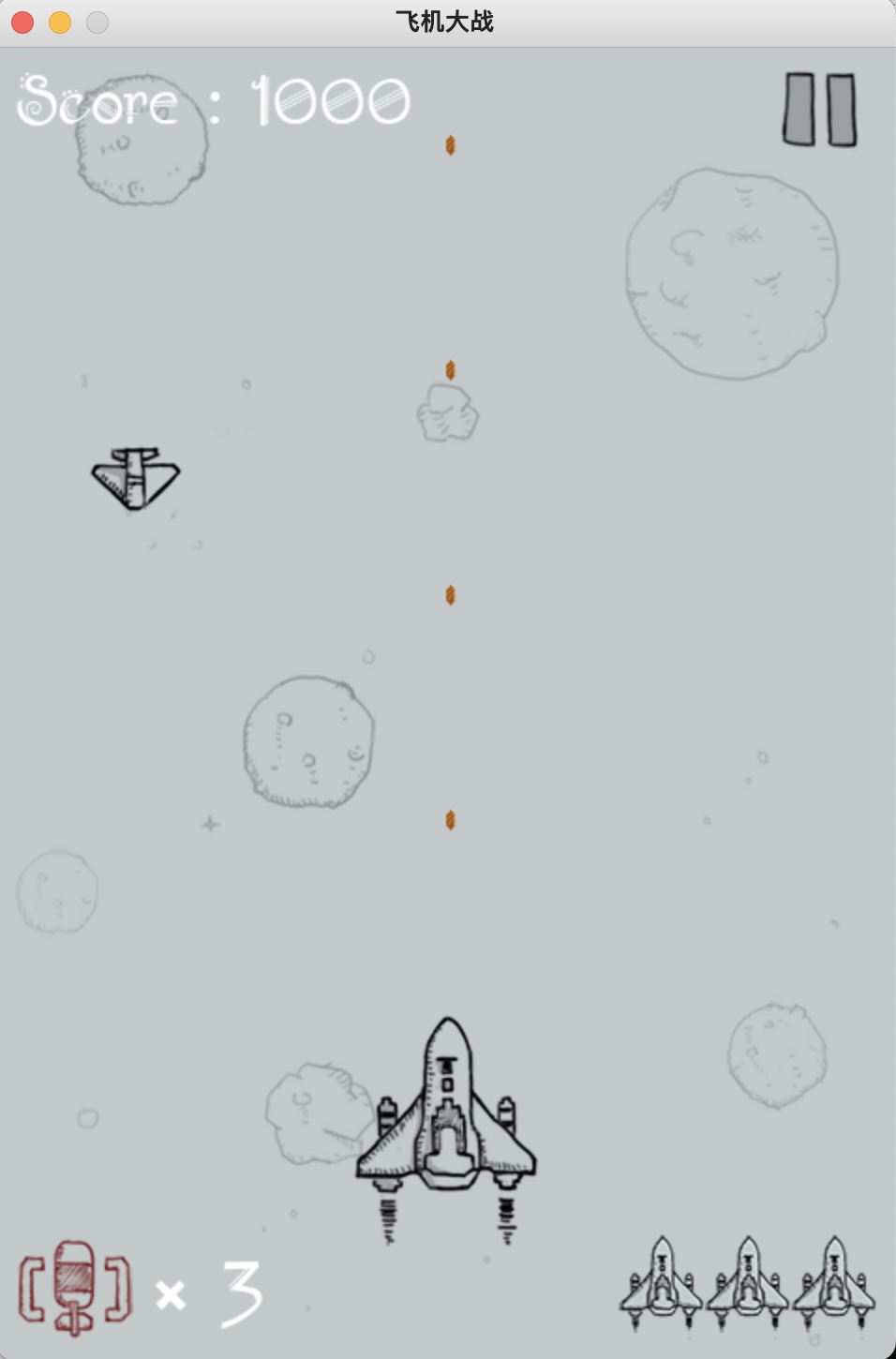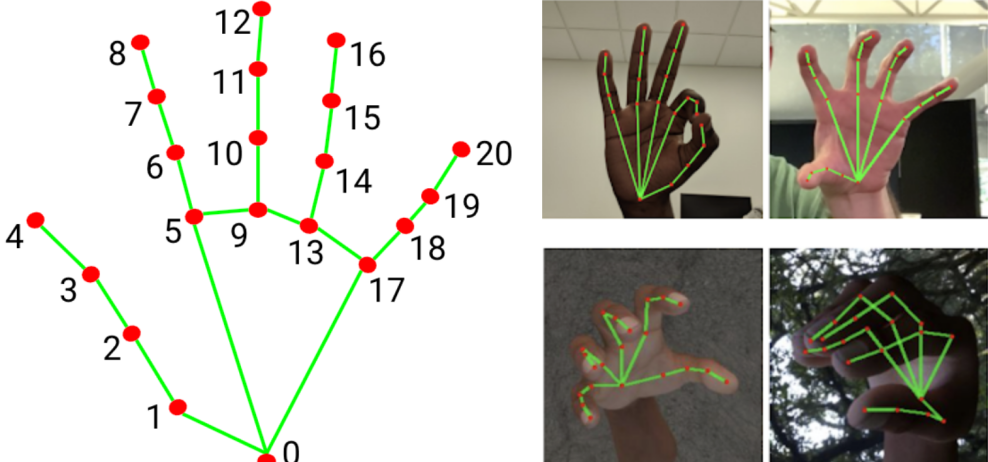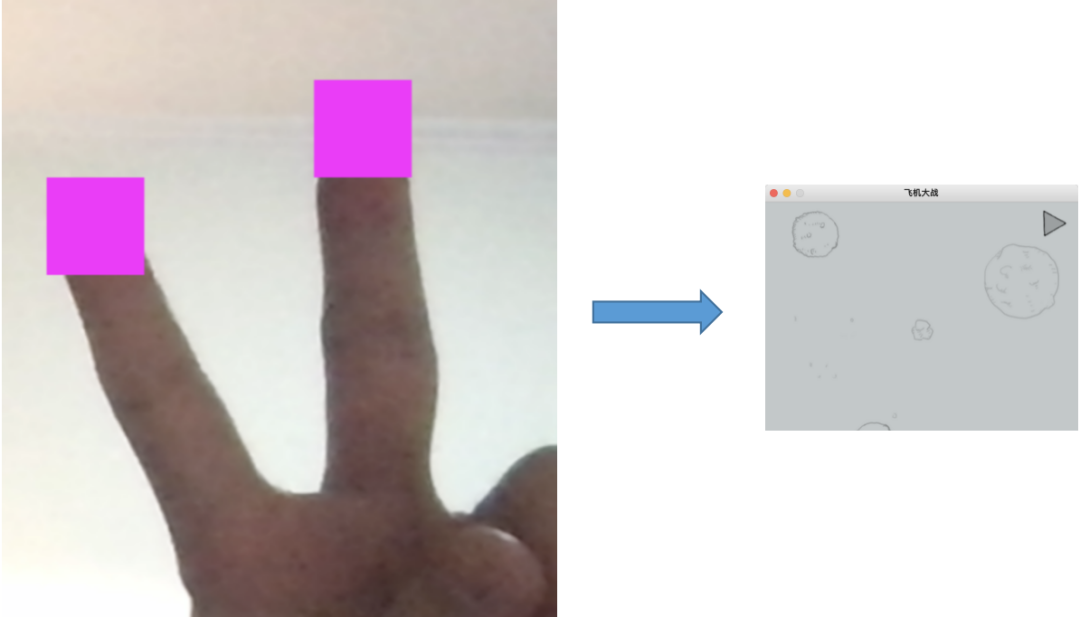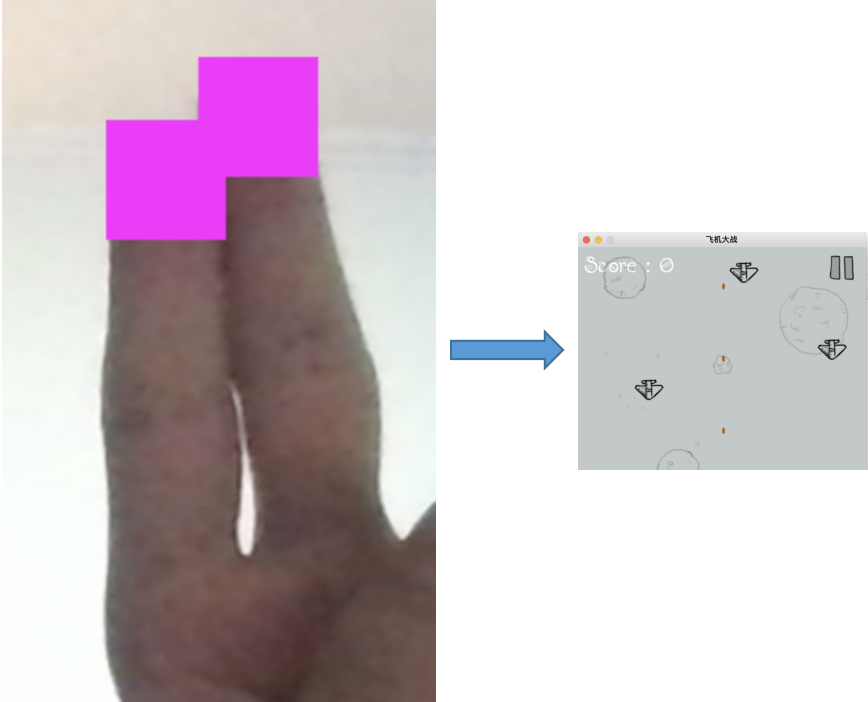AI virtual gestures to play airplane battle
Hello, everyone.
Let’s break down this small project and take you through the implementation step by step. At the end of the article, we will obtain the complete source code of the project.
1. Prepare the aircraft war program
Find a Python version of the aircraft war program on Github, install Pygame and run it.

The game operation is simple. In the upper right corner is the game pause/start button, which can be operated by clicking with the mouse.
The A, D, W, and S keys on the keyboard are used to control the movement direction of the aircraft, corresponding to left, right, up, and down respectively.
So our AI program must complete two core functions. First, recognize gestures; second, convert gestures into mouse and keyboard operations to control the game.
2. Recognize gestures
Here, we use opencv to read the video stream from the camera.
Send each frame in the video stream to the palm detection model in mediapipe to identify 21 key points of the palm.

In our project, only the index finger and middle finger are used, which are the 8th and 12th points on the left and right.
The core code is as follows:
ret, frame = cap.read() results = hands.process(frame[:, :, ::-1]) if results.multi_hand_landmarks: # 遍历每个手掌 for hand_landmarks in results.multi_hand_landmarks: finger_axis_8 = hand_landmarks.landmark[8] finger_axis_12 = hand_landmarks.landmark[12]
frame is each frame in the video stream, and hands is the palm detection model.
The parsed finger_axis_8 and finger_axis_12 objects store the x and y coordinates of the index finger and middle finger respectively.
3. Gesture control to pause the game
Calculate the distance between the coordinates of the index finger and middle finger. If it is greater than a certain threshold, move the mouse and click the pause game button.

Game pause
If the distance between the coordinates of the index finger and middle finger is less than a certain threshold, move the mouse and click the start game button

Game Start
Distance calculation is very simple. I won’t post the code here. The focus is on Python controlling the mouse.
I use the PyUserInput library, which provides two classes, PyMouse and PyKeyboard, to control the mouse and keyboard respectively.
When we want to use a Python program to control the pause and start of the game, we only need to move the mouse to the position of the button and perform a click operation.
# 定义鼠标对象 self.mouse = PyMouse() def pause_or_start_game(self, dist): """ 判断是否需要暂停(开始)游戏 :param dist: :return: """ if (not self.is_pause and dist > 80) or (self.is_pause and dist < 80): self.mouse.move(915, 125) self.mouse.click(915, 125) self.is_pause = not self.is_pause
The parameter dist of the pause_or_start_gamefunction is the distance between the index finger and the middle finger.
The coordinates of the pause/start button are (915, 125). The coordinates of each computer are different. You need to recalculate according to your actual situation.
The calculation idea is very simple. The game border size is (480, 700), and the game is started in the middle of the screen. As long as the size of the screen is obtained, the coordinates of the buttons can be roughly estimated. After calling PyMouse's move function, check and fine-tune it.
The move function of PyMouse is used to move the mouse position, and the click function is used to perform mouse click operations.
4. Gesture control of aircraft movement
Here, you need to calculate the movement direction and distance of the x coordinate and y coordinate of the index finger in two adjacent frames. This determines which of the keyboards A, D, W, and S is pressed.
Similarly, the direction and distance of movement are very simple and will not be discussed here. The focus is on the control of keyboard keys by the PyKeyboard module.
self.key_board = PyKeyboard() # 按下按键 self.key_board.press_key(key) # 停留一段时间 time.sleep(press_dwell) # 释放按键 self.key_board.release_key(key)
Between the press_key and release_key functions, time.sleep(press_dwell) is called to control the duration of the key. If the key is pressed for a long time, the distance the aircraft moves will be long. On the contrary, if the key time is short, the distance the aircraft will move will be short.
So, the difficulty here is how to map the movement distance of the index finger to the duration of the key press.
I used the following code to measure it
for i in range(n):
kb.press_key('A')
time.sleep(0.05)
kb.release_key('A')The fixed key duration is 0.05 seconds, and the test aircraft moves from the middle to the far left, which requires the smallest n.

The aircraft moves from the middle to the far left, and the moving distance is 240. Therefore, 240 / (n * 0.05) is the moving distance of the aircraft per second.
I measured n=7, therefore, the distance the aircraft moves per second is 685.7142857.
As long as you calculate the movement distance of your index finger and divide it by 685.7142857, you can get the key duration of the keyboard.
The complete code for gesture control of aircraft movement is:
def press_key_board(self, direction, move_dist): """ 将手指移动距离,换算为按键间隔,并执行按键操作 :param direction:移动方向 :param move_dist:移动距离 :return: """ dist_per_sec = 685.7142857 if direction == 'x': key = 'A' if move_dist < 0 else 'D' elif direction == 'y': key = 'W' if move_dist < 0 else 'S' else: return press_dwell = math.fabs(move_dist / dist_per_sec) self.key_board.press_key(key) time.sleep(press_dwell) self.key_board.release_key(key)
The core part of the project has been explained, and the complete code has been sorted out. If you need it, just leave a message in the comment area.
After obtaining the code, first look at the running steps.txt.
If you think this article is useful to you, please click "Read it" to encourage me. I will continue to share excellent Python AI projects in the future.
The above is the detailed content of AI virtual gestures to play airplane battle. For more information, please follow other related articles on the PHP Chinese website!

Hot AI Tools

Undresser.AI Undress
AI-powered app for creating realistic nude photos

AI Clothes Remover
Online AI tool for removing clothes from photos.

Undress AI Tool
Undress images for free

Clothoff.io
AI clothes remover

AI Hentai Generator
Generate AI Hentai for free.

Hot Article

Hot Tools

Notepad++7.3.1
Easy-to-use and free code editor

SublimeText3 Chinese version
Chinese version, very easy to use

Zend Studio 13.0.1
Powerful PHP integrated development environment

Dreamweaver CS6
Visual web development tools

SublimeText3 Mac version
God-level code editing software (SublimeText3)

Hot Topics
 What are the types of return values of c language function? Summary of types of return values of c language function?
Apr 03, 2025 pm 11:18 PM
What are the types of return values of c language function? Summary of types of return values of c language function?
Apr 03, 2025 pm 11:18 PM
The return value types of C language function include int, float, double, char, void and pointer types. int is used to return integers, float and double are used to return floats, and char returns characters. void means that the function does not return any value. The pointer type returns the memory address, be careful to avoid memory leakage.结构体或联合体可返回多个相关数据。
 How to use C language function pointer to find the maximum value of a one-dimensional array
Apr 03, 2025 pm 11:45 PM
How to use C language function pointer to find the maximum value of a one-dimensional array
Apr 03, 2025 pm 11:45 PM
Flexible application of function pointers: use comparison functions to find the maximum value of an array. First, define the comparison function type CompareFunc, and then write the comparison function compareMax(a, b). The findMax function accepts array, array size, and comparison function parameters, and uses the comparison function to loop to compare array elements to find the maximum value. This method has strong code reusability, reflects the idea of higher-order programming, and is conducive to solving more complex problems.
 CS-Week 3
Apr 04, 2025 am 06:06 AM
CS-Week 3
Apr 04, 2025 am 06:06 AM
Algorithms are the set of instructions to solve problems, and their execution speed and memory usage vary. In programming, many algorithms are based on data search and sorting. This article will introduce several data retrieval and sorting algorithms. Linear search assumes that there is an array [20,500,10,5,100,1,50] and needs to find the number 50. The linear search algorithm checks each element in the array one by one until the target value is found or the complete array is traversed. The algorithm flowchart is as follows: The pseudo-code for linear search is as follows: Check each element: If the target value is found: Return true Return false C language implementation: #include#includeintmain(void){i
 What are the pointer parameters in the parentheses of the C language function?
Apr 03, 2025 pm 11:48 PM
What are the pointer parameters in the parentheses of the C language function?
Apr 03, 2025 pm 11:48 PM
The pointer parameters of C language function directly operate the memory area passed by the caller, including pointers to integers, strings, or structures. When using pointer parameters, you need to be careful to modify the memory pointed to by the pointer to avoid errors or memory problems. For double pointers to strings, modifying the pointer itself will lead to pointing to new strings, and memory management needs to be paid attention to. When handling pointer parameters to structures or arrays, you need to carefully check the pointer type and boundaries to avoid out-of-bounds access.
 What are c language function pointers and pointer functions? What's the difference?
Apr 03, 2025 pm 11:54 PM
What are c language function pointers and pointer functions? What's the difference?
Apr 03, 2025 pm 11:54 PM
A function pointer is a pointer to a function, and a pointer function is a function that returns a pointer. Function pointers point to functions, used to select and execute different functions; pointer functions return pointers to variables, arrays or other functions; when using function pointers, pay attention to parameter matching and checking pointer null values; when using pointer functions, pay attention to memory management and free dynamically allocated memory; understand the differences and characteristics of the two to avoid confusion and errors.
 What does the c language function return pointer output?
Apr 03, 2025 pm 11:36 PM
What does the c language function return pointer output?
Apr 03, 2025 pm 11:36 PM
The C language function returns a pointer to output a memory address. The pointing content depends on the operation inside the function, which may point to local variables (be careful, memory has been released after the function ends), dynamically allocated memory (must be allocated with malloc and free), or global variables.
 What are the formats of function definition in C language?
Apr 03, 2025 pm 11:51 PM
What are the formats of function definition in C language?
Apr 03, 2025 pm 11:51 PM
The key elements of C function definition include: return type (defining the value returned by the function), function name (following the naming specification and determining the scope), parameter list (defining the parameter type, quantity and order accepted by the function) and function body (implementing the logic of the function). It is crucial to clarify the meaning and subtle relationship of these elements, and can help developers avoid "pits" and write more efficient and elegant code.
 What do nested calls and recursive calls of c language functions mean respectively?
Apr 03, 2025 pm 11:09 PM
What do nested calls and recursive calls of c language functions mean respectively?
Apr 03, 2025 pm 11:09 PM
C language function calls can be divided into nested calls and recursive calls. Nested calls refer to calling other functions within a function, nesting them layer by layer. Recursive calls refer to the function itself calling itself, which can be used to deal with self-similar structure problems. The key difference is that the functions in nested calls are called in sequence, with independent interaction scopes, while the functions in recursive calls are constantly called, so you need to pay attention to the recursive basis and stack overflow issues. Which calling method to choose depends on the specific requirements and performance requirements of the problem.






